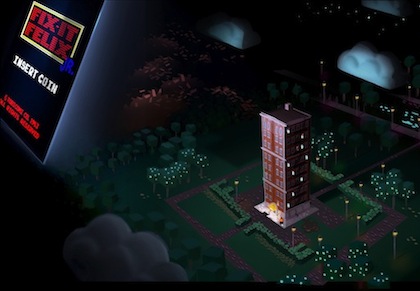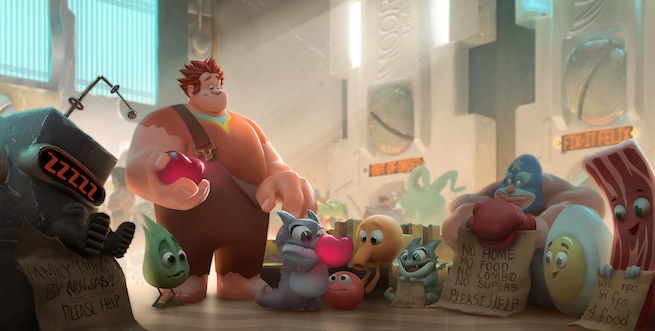Some parts of this interview contain spoilers for the film Wreck-It Ralph.
Litwak’s Arcade is a special place. But you wouldn’t be able to tell by its aging ceramic tiles or by the missing letters in the dilapidated birthday sign posted outside. Despite all odds, the “family fun center” manages to stay profitable in a time where most standalone arcades have failed.
Strangely, it’s also a hard place to find. The TV commercials only mention that its location is off the nebulous “Route 83.” And Google results won’t return a website — much less a phone number. So how do you get there?
Unfortunately, you can’t. Litwak’s Arcade doesn’t actually exist.
It’s merely the setting for Disney’s Wreck-It Ralph, an animated film about video games that opened nationwide in theaters last week. Packed with characters from real electronic entertainment titles — along with a slew of other references that’ll have you freeze-framing every second when it’s out on DVD — the movie tells a charming and surprisingly emotional adventure about its titular villain who “jumps” from one arcade game to the next to solve his mid-life crisis.
Perhaps more interesting than Wreck-It Ralph, though, is the story behind the making of the film. GamesBeat spoke with producer Clark Spencer and later to screenwriter Phil Johnston and director Rich Moore to reveal the challenges, the delightful accidents, and the insane ideas they had during the three-year-long project.
GamesBeat: Why make Ralph a video game villain as opposed to, say, a bad guy in a fairy tale?
Clark Spencer: Since Rich Moore first came to Disney, he had this idea telling the story about a guy who wakes up one day after 30 years of doing the same thing and thinks, “Isn’t there something more to life?” But he didn’t know what world he was going to set that story in, and John Lasseter, who’s our chief creative officer, said we should think about the world of video games.
But it wasn’t as much thinking of you should tell a video game story because no one’s done it. It was more that the right story and the right world came together at the right moment because … this story could be told in a lot of different worlds or universes. Video games is just one of them.
 GamesBeat: What’s the role of the video game cameos? Are they just there to contextualize the film’s world?
GamesBeat: What’s the role of the video game cameos? Are they just there to contextualize the film’s world?
Spencer: [Phil and Rich] wanted to make sure that, as much as possible, [the cameos] were organic and integral to the storytelling. We screen our movies a lot before we do the final version. In the first two times we screened the movie, we didn’t have that Bad Guys Anonymous scene. We had a different way of getting into it.
But it was taking us a long time to set up who Ralph was and what his problem was through a lot of dialogue. And someone came up with the idea of “What if we put him into a Bad Anon group?” Now we can actually bring video game characters in and it’s integral to the story — they’re telling us who Ralph is, and Ralph is telling us what his problem is in that world.
[And] when you see Sonic, it feels like Sonic is telling us the stakes of the world by saying if you die outside your game, you don’t ever regenerate. As much as possible, we tried to make sure we’re doing the right match up of storytelling, information that helps propel the story forward, with the right characters.
GamesBeat: Did you have a worst-case scenario plan in place if none of your requests for these characters went through?
Spencer: It was probably the thing I was the most angst-ridden about because every day, somebody would come up with some other great idea. And you think it’s going to make the movie so funny or emotional … but are we really gonna be able to pull all of this off? So what we said was, “What are the four most important characters to be in this movie?”
We decided it was Bowser, Q*bert, Clyde the ghost, and Sonic. We felt like if we can get those four, we can figure out the rest. And there was one more from Phil … he’s a huge Street Fighter fan, so Zangief was majorly important to him. [Laughs] We started out with those companies first. And [companies] were actually entertaining this idea. They weren’t saying no to us right away. They were actually listening and getting interested.
And that’s when we got a lot bigger in terms of the number of characters we were going to put into the film. But you still wonder if there’s going to be that day where someone says, “You can’t have this.” And we’ve built everything around it. We built so much around the idea that Q*bert is homeless. What happens if Sony doesn’t say yes?
[The films] Toy Story and Roger Rabbit kind of broke a lot of the ground for us. So companies were more open to it. They saw [their characters] all the way through the process.
GamesBeat: What was the idea behind the film’s aggressive marketing to make Fix-It Felix Jr. look like a real game from the ’80s with real arcade cabinets and a Flash-based online game?
Spencer: [Rich said] we need to create an actual Fix-It Felix Jr. game. And then we need to figure out how do we get it out there and have people think that game was actually real in 1982. So we brought in a developer who made 8-bit games in the 1980s. They brought in the old motherboards from the ’80s to try to make it exactly authentic as opposed to using today’s technology.
And we’re lucky we work for a Walt Disney company. We have people at the theme parks who know how to take things and age it. Each cabinet — I think there are 75 they’ve made so far — each one is different in terms of where the aging happens and what they chose to do.
Once that idea was there, we thought, “Why don’t we try to create other things to add to the authenticity?” They released an online commercial for Litwack’s Arcade (embedded below). They have a Fix-It Felix Jr. one, the Sugar Rush one is out there now, and I think the Hero’s Duty one is coming soon. And all three add up in terms of … how commercial technology might have evolved from 1980 to 1990 to today.
And all of it is about trying to create a history where these games could have been part of the actual gaming world.
[youtube http://youtu.be/wF_LJfwFsE4][Editor’s note: At this point, Clark Spencer had to leave. Screenwriter Phil Johnston came in to continue the conversation.]
GamesBeat: Did you face any challenges trying to integrate video games into the core storyline that was already there?
Phil Johnston: Not really. We knew it was going to be a video game movie. We just wanted the characters to be three-dimensional: have real human needs and flaws and stuff like that.
But before we got too heavy into how could it work … . Well, first, we had no idea how they got from game to game. We had this harebrained idea where [the characters] were going to travel through a vortex in the toilet — literally, that was the idea that for a few days stuck [Laughs]. And we were like yeah, that makes sense!
GamesBeat: Throughout the movie, Ralph tries to make himself a hero. So why didn’t he get a hero’s ending?
Johnston: There was never going to be a moment where he was “the hero.” And the fact is, the world he’s saving is a mess he has created.
[Director Rich Moore joins us.]
The more important journey is the relationship he forges with another human being he cares about more than himself, which is a much more personal moment of heroism I would say. For his arc, we always thought of it as [going from] selfish to selfless. However many iterations the story took, that was always the goal.
Rich Moore: You have to kind of try things to get the gold, I think. The conceit of how they travel from game to game [through the toilet] — we were convinced that was it. Like we had cracked it. If there was one thing that was gonna stay in this movie, dammit, it’s the fact that … .
 Johnston: Felix chases a nail through a toilet, and it’s a portal! [Laughs]
Johnston: Felix chases a nail through a toilet, and it’s a portal! [Laughs]
Moore: [Laughs] It had nothing to do with video games. But that’s the process: trying stuff and letting it have its day in court. We’ll realize, “That’s bad. What were we thinking?” But you just have to kind of be brave enough to put it out there and sit with it for a while and not be ashamed.
Johnston: Ralph had a horn! Ralph discovered that he had a horn when he got a haircut. It was so weird, the nonsense [that we came up with].
Moore: But it helps us get to the end.
GamesBeat: One of the pleasant surprises of the film was Ralph’s side-kick Vanellope and the way comedian Sarah Silverman portrayed her.
Moore: Right? What really put me over the top for Sarah was her autobiography, The Bedwetter. I loved her view of childhood and what that was like growing up. I really wanted to tap into that — of her whole take of what it was to be young. She was sweet and naïve but would say these inappropriate things at family functions. That’s really the crux of Vanellope.
Johnston: Boy was she dedicated. The thing that surprised me the most about her was the places she allowed herself to go emotionally in those heavier scenes.
Moore: When the whole thing came about the idea of Vanellope being the princess at the end — I remember pitching that idea to her. She was like, “No, no, no! ” But [when we showed how] Vanellope kind of rejects that, she [was relieved].
Johnston: And I think the cool thing about it is that the movie totally honors the emotions that Disney movies have always had. But it also says there is this other version of things where you don’t have to be a princess.
VentureBeat's mission is to be a digital town square for technical decision-makers to gain knowledge about transformative enterprise technology and transact. Learn More


